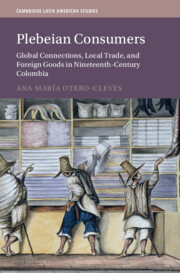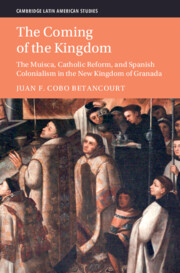289 results
Homologies and modelling in Colombian South–South security cooperation
-
- Journal:
- European Journal of International Security , First View
- Published online by Cambridge University Press:
- 14 March 2025, pp. 1-21
-
- Article
-
- You have access
- Open access
- HTML
- Export citation
20 - The Right to Freedom of Thought in Colombia
- from Part V - Americas
-
-
- Book:
- The Cambridge Handbook of the Right to Freedom of Thought
- Published online:
- 06 March 2025
- Print publication:
- 13 March 2025, pp 253-264
-
- Chapter
- Export citation
Business engagement in gender equality policy: roles, contributions, and expectations
-
- Journal:
- Journal of Public Policy , First View
- Published online by Cambridge University Press:
- 10 March 2025, pp. 1-28
-
- Article
-
- You have access
- Open access
- HTML
- Export citation
Containment or bad detection? Poor state capacity implications on reported Covid-19 cases
-
- Journal:
- Journal of Institutional Economics / Volume 21 / 2025
- Published online by Cambridge University Press:
- 19 February 2025, e3
-
- Article
-
- You have access
- Open access
- HTML
- Export citation
El espacio urbano en la protesta social: Bogotá y Cali en las manifestaciones de 2021
-
- Journal:
- Latin American Research Review ,
- Published online by Cambridge University Press:
- 20 January 2025, pp. 1-23
-
- Article
-
- You have access
- Open access
- HTML
- Export citation
Gone with the Rebels: Reshaping Local Orders in Post-Peace Agreement Colombia
-
- Journal:
- Latin American Politics and Society , FirstView
- Published online by Cambridge University Press:
- 07 January 2025, pp. 1-25
-
- Article
-
- You have access
- Open access
- HTML
- Export citation
Utilising mitochondrial barcode sequencing to evaluate phylogeographical structure and guide the release of illegally traded Amazon parrots
-
- Journal:
- Bird Conservation International / Volume 34 / 2024
- Published online by Cambridge University Press:
- 20 December 2024, e43
-
- Article
-
- You have access
- HTML
- Export citation

Plebeian Consumers
- Global Connections, Local Trade, and Foreign Goods in Nineteenth-Century Colombia
-
- Published online:
- 18 December 2024
- Print publication:
- 05 December 2024
Factor validation of the International Trauma Questionnaire in a sample of trauma-exposed Colombian adults in the MI-VIDA study
-
- Journal:
- BJPsych Open / Volume 11 / Issue 1 / January 2025
- Published online by Cambridge University Press:
- 13 December 2024, e6
-
- Article
-
- You have access
- Open access
- HTML
- Export citation
Conclusion
-
- Book:
- The Coming of the Kingdom
- Published online:
- 29 November 2024
- Print publication:
- 12 December 2024, pp 305-310
-
- Chapter
-
- You have access
- Open access
- HTML
- Export citation
2 - Conservative Parties in Latin America in Adverse Times
- from Part I - Building Right-Wing Parties and Partisans
-
-
- Book:
- The Recasting of the Latin American Right
- Published online:
- 29 November 2024
- Print publication:
- 12 December 2024, pp 55-73
-
- Chapter
- Export citation
Chapter Eight - The Occupation Constitution III
-
- Book:
- A Sociology of Post-Imperial Constitutions
- Published online:
- 06 December 2024
- Print publication:
- 12 December 2024, pp 405-437
-
- Chapter
- Export citation
4 - The Uneven Success of Uribismo in Colombia
- from Part I - Building Right-Wing Parties and Partisans
-
-
- Book:
- The Recasting of the Latin American Right
- Published online:
- 29 November 2024
- Print publication:
- 12 December 2024, pp 95-114
-
- Chapter
- Export citation
Chapter Four - Imperial Nations in Latin America
-
- Book:
- A Sociology of Post-Imperial Constitutions
- Published online:
- 06 December 2024
- Print publication:
- 12 December 2024, pp 220-269
-
- Chapter
- Export citation
Introduction
-
- Book:
- The Coming of the Kingdom
- Published online:
- 29 November 2024
- Print publication:
- 12 December 2024, pp 1-18
-
- Chapter
-
- You have access
- Open access
- HTML
- Export citation

Crime, Insecurity, and Community Policing
- Experiments on Building Trust
-
- Published online:
- 09 December 2024
- Print publication:
- 05 December 2024
8 - Do Police–Community MeetingsWork? Experimental Evidence from Medellín, Colombia
- from Part II - The Effects of Community Policing
-
-
- Book:
- Crime, Insecurity, and Community Policing
- Published online:
- 09 December 2024
- Print publication:
- 05 December 2024, pp 226-256
-
- Chapter
- Export citation

The Coming of the Kingdom
- The Muisca, Catholic Reform, and Spanish Colonialism in the New Kingdom of Granada
-
- Published online:
- 29 November 2024
- Print publication:
- 12 December 2024
-
- Book
-
- You have access
- Open access
- Export citation
4 - Hydrogen Regulation in Latin America
- from Part I - Current Hydrogen Regulation on the Continents
-
-
- Book:
- The Cambridge Handbook of Hydrogen and the Law
- Published online:
- 28 November 2024
- Print publication:
- 28 November 2024, pp 46-64
-
- Chapter
-
- You have access
- Open access
- HTML
- Export citation

Reimagining Radical Democracy in the Global South
- Emerging Paradigms from Colombia and Türkiye
-
- Published online:
- 22 November 2024
- Print publication:
- 02 January 2025
-
- Element
- Export citation


